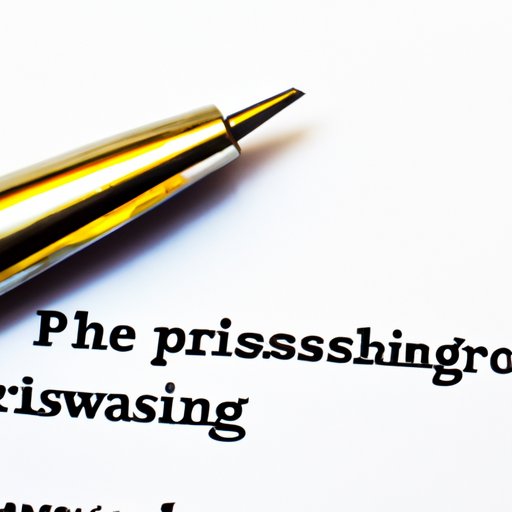I. Introduction
Paraphrasing is a crucial skill for anyone who wants to produce high-quality writing. By rewording text in a way that is both accurate and original, you can strengthen your arguments, avoid plagiarism, and create writing that is both engaging and informative.
However, paraphrasing can be a challenge for many people. Some struggle with finding the right words to convey the meaning of the original text, while others may inadvertently plagiarize by failing to properly cite their sources.
In this article, we’ll explore the art of paraphrasing and provide you with the tools, tips, and techniques you need to become a master at rewriting text.
II. The Art of Paraphrasing: A Step-by-Step Guide
Paraphrasing can be broken down into several manageable steps:
- Read and understand the original text
- Identify the key ideas and concepts
- Rewrite the text in your own words, without changing the meaning
- Check your reworded text against the original to ensure accuracy.
To reword sentences effectively, try the following tips:
- Start by breaking the original sentence down into smaller components
- Replace complex words with simpler synonyms
- Vary the sentence structure while retaining the original meaning
- Use quotes or paraphrase only the parts of sentences that add value to your argument
- Use a thesaurus when struggling with synonyms.
It’s important to avoid plagiarism when paraphrasing. Some strategies include:
- Cite your sources by referencing the original work
- Consider using a plagiarism checker tool
- Use direct quotes when necessary
- Keep track of your sources to make proper citations easier
III. Paraphrasing Made Easy: Tools and Techniques for Accurate Rewriting
There are several tools available for those who want to paraphrase text. Some of the best are:
- Paraphrasing tools such as the ones provided by Grammarly
- Text spinners such as Spinbot or Chimp Rewriter
- Manual rephrasing techniques like the ones outlined in this article
Effective paraphrasing can involve using specific techniques such as:
- Using synonyms and different phrasing
- Changing the order of words or sentences
- Adding or removing information while retaining the original meaning
IV. The Do’s and Don’ts of Paraphrasing
Common mistakes people make when paraphrasing include:
- Copying too much text from the original work
- Changing only a few words while retaining the original sentence structure
- Not properly citing sources or relying too heavily on paraphrasing tools
To avoid these mistakes and create original content, try the following:
- Take notes while reading to ensure you understand the original text
- Use a variety of techniques when paraphrasing
- Cite your sources properly by referencing the original work
- Proofread your rewording carefully to ensure accuracy and originality
V. Why Paraphrasing Matters: Using Rewritten Text to Strengthen Your Writing
Paraphrasing can offer several benefits that can strengthen your writing:
- Improving the clarity of your writing by simplifying complex ideas
- Avoiding plagiarism by using your own words to convey important information
- Strengthening your research by helping you better understand the original text
- Developing your writing skills by encouraging you to think more critically about the material
VI. Paraphrasing with Confidence: Tips for Students and Professionals
If you’re new to paraphrasing, keep these key principles in mind:
- Always start by reading and understanding the original text
- Use a variety of techniques to paraphrase effectively
- Cite your sources properly to avoid plagiarism
- Proofread your rewording carefully to ensure accuracy and originality
VII. From Research to Writing: A Paraphrasing Handbook
Paraphrasing plays an important role in the research process. To use it effectively:
- Read the material carefully to understand the central ideas
- Paraphrase the text in your notes while researching
- Use paraphrasing techniques to integrate sources smoothly into your writing
- Make sure to cite your sources properly to avoid plagiarism
VIII. The Ethics of Paraphrasing: How to Cite Sources and Stay on the Right Side of the Law
When it comes to paraphrasing, there are legal and ethical implications to consider. To stay on the right side of the law:
- Cite your sources properly by referencing the original work
- Avoid using too much text from the original source without permission
- Never claim someone else’s work as your own
IX. Conclusion
Paraphrasing is an essential skill for anyone who wants to produce high-quality writing that is both accurate and original. By following the tips and techniques outlined in this guide, you can become a master of the art of paraphrasing. Remember to always cite your sources properly, proofread your work carefully, and never claim someone else’s work as your own. With practice, you can begin to create truly original and engaging content that is sure to impress.
